Decades ago, the Back River Wastewater Treatment Plant was considered a state-of-the-art facility as the largest in Maryland. It’s designed to process and discharge up to 180 million gallons of treated wastewater into the Back River which flows into the Chesapeake Bay. State Sen. Johnny Ray Salling, who represents the Dundalk area around the plant, remembers field trips there when he was a student at Sparrows Point High School.
“It was one of the best in the world, let alone in this nation,” he recalled during a tour of the plant Wednesday. “And they knew that. That's why they could do field trips. That's why it was open to the public. People could come here and check this facility out.”
Baltimore City’s Department of Public Works operates the plant for city and county residents but significant state funding has been earmarked for the plant.
Even two years ago, the state installed new technology inside the wastewater treatment plant to remove nutrients that are harmful to Chesapeake Bay waters, said Lee Currey, director of science services for the Maryland Department of the Environment.
“The Back River Wastewater Treatment Plant was really operating at very efficient levels,” he said. “It was showcased in terms of a restoration.”
But things went south fast at the city-controlled plant.
When state inspectors showed up earlier this year they found serious maintenance problems that allowed excess discharges of nutrients and bacteria into Back River. The state report contained photographs of tanks and channels clogged with backed-up solids and equipment jammed with vegetation.

In March, the Department of the Environment ordered the Maryland Environmental Service, a government agency that usually operates smaller sewage treatment plants, to take over the operation from Baltimore City and fast track needed repairs.
Things have gotten better since then, Currey said, but the plant still has a long way to go.
“It's not resilient yet. It still needs a lot of work in terms of staffing, maintenance and organization and operation,” he said.
The state Senate Budget and Taxation Committee took a tour of the wastewater treatment plant on Wednesday.
State Sen. and committee chair Guy Guzzone, said the state has spent nearly $1 billion in upgrades to this plant and the Patapsco Wastewater Treatment Plant over the years. The committee wants to make sure the money is well spent.
“Regardless of the number, the state is obviously very interested in this,” he said. “We've made a major commitment and the impact on public health and the Bay is substantial.”
Back River and Patapsco are among five wastewater treatment plants in Maryland that combined contribute between 75% and 90% of the nutrients to Chesapeake Bay coming from such facilities.
Guzzone said the significance of the problems the committee became aware of last winter was shocking. And he complimented “those involved coming in from various departments of government to make improvements and those improvements are happening.”
Michael Hallmen, head of the Baltimore Public Works Department’s Wastewater Facilities Division, led the tour. He said many of the problems with the plant were tied to a loss of workers and a lack of maintenance, some of which stemmed from the loss of personnel.
The plant had an aging workforce to begin with and had a number of workers who retired rather than stick it out during the COVID crisis, he said.
“And some of those folks that did hang on, are now nearing their 35-to-40-year mark,” Hallmen added. “And so, they're ready to move on and retire as well.”
Now, the department is focusing on bringing in new workers through a three-year apprenticeship program, which he says will help in the long run.
Meanwhile, he added, they have “some other contingency plans for the near term with the use of outside consultants and operations folks, and maintenance folks in that end. But it's really about rebuilding our staff that's been depleted for a number of reasons over the past five to seven years.”
Hallmen said the plant had been operated on a “run to fail '' theory of maintenance — run a piece of equipment until it fails, then bring in a back-up, run it hard and hope it lasts until the original equipment is repaired. That's been changed.
“We're focused more on the preventive and catching issues before they become much greater problems and being able to have support in place to act on them in a more timely fashion,” he said.
Now, clear water tumbles down sluices, otherwise known as a sliding gate, a few yards from the Back River shore and into a pipe that sends it into the river.
State Sen. Sarah Elfreth, a member of the Budget and Tax Committee and the Chesapeake Bay Commission, acknowledged the advances at the plant, but at the same time, she’s worried.
“The next question is how do we prevent the next break?” she asked. “And what kind of systems are we going to have in place, both from a capital side, but more importantly, a staffing and maintenance side to make sure that we don't have the same problems moving into the future?”
She called it “kind of a moving target.”











